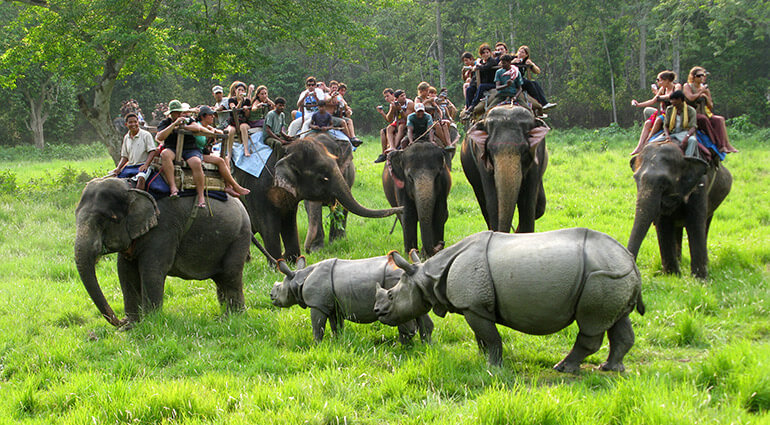Discovering the Wilderness of Chitwan National Park: A Trip into the Heart of Nature
Introduction
Chitwan National Park, located in the lowlands of south-central Nepal, is a vast stretch of lush green forests, marshlands, and meadows. Recognized as a UNESCO World Heritage Site, it is one of the most sought-after wildlife destinations in Asia. Covering an area of 932 square kilometers, the park is a refuge for a diverse range of flora and fauna, offering visitors an unrivaled opportunity to experience the beauty and complexity of nature. This 1,000-word exploration delves into the park’s rich biodiversity, historic importance, conservation efforts, and the unique experiences it offers to travelers and nature enthusiasts.
Historical Value
Chitwan National Park’s history is deeply intertwined with the conservation movement in Nepal. Established in 1973 as Nepal’s first national park, its creation marked a significant milestone in the country’s efforts to preserve its natural heritage. Before its designation as a protected area, the region was known as a hunting ground for Nepalese royalty and foreign dignitaries. However, the alarming decline in wildlife populations, particularly the rhinoceros and tiger, prompted the government to take action.
The establishment of the park was driven by the need to protect the dwindling populations of these iconic species. Conservation efforts were further strengthened by international support and collaboration, leading to the implementation of various programs aimed at habitat restoration and anti-poaching measures. Today, Chitwan National Park stands as a testament to successful conservation practices, showcasing the balance between human intervention and natural preservation.
Biodiversity and Wildlife
The biodiversity of Chitwan National Park is one of its most striking features. The park is home to over 700 species of wildlife, including some of the most endangered animals in the world. Among its most celebrated residents are the Bengal tiger and the one-horned rhinoceros. These majestic creatures symbolize the park’s success in wildlife conservation.
The park’s varied ecosystems support a wide range of animals, including elephants, sloth bears, leopards, and numerous species of deer. The marshlands and rivers are inhabited by the endangered gharial crocodile and the elusive Gangetic dolphin. Birdwatchers can revel in the presence of over 500 species of birds, making it a paradise for ornithologists. From the colorful Indian peafowl to the majestic lesser adjutant stork, the avian diversity is truly remarkable.
The park’s flora is equally diverse, with dense sal forests, riverine vegetation, and expansive grasslands providing the perfect habitat for its inhabitants. The rich plant life not only sustains the wildlife but also plays a crucial role in maintaining the ecological balance of the region.
Conservation Efforts
Chitwan National Park’s conservation story is one of resilience and determination. The park’s management has implemented numerous measures to protect and sustain its ecosystems. Anti-poaching units patrol the park to safeguard its inhabitants, while community-based conservation programs have been instrumental in involving local populations in the preservation efforts.
The park’s buffer zones, established to reduce human-wildlife conflict, have been effective in promoting sustainable practices among the local communities. These zones serve as a transition area where human activities are regulated to minimize their impact on the core protected area. Eco-tourism initiatives have also been developed to provide alternative livelihoods for the locals, reducing their dependence on forest resources.
Research and monitoring are integral to the park’s conservation strategy. Various organizations and institutions collaborate to conduct studies on wildlife behavior, habitat utilization, and population dynamics. This scientific approach ensures that conservation practices are informed by accurate data, enhancing their effectiveness.
Unique Experiences
Visiting Chitwan National Park offers a multitude of unique experiences that immerse travelers in the natural world. One of the most popular activities is the jungle safari, which can be undertaken on foot, by jeep, or even on elephant back. These safaris provide a thrilling opportunity to observe wildlife up close in their natural habitat. The chance to spot a Bengal tiger or a one-horned rhinoceros in the wild is an unforgettable experience.
Canoe rides along the Rapti and Narayani rivers offer a different perspective of the park’s biodiversity. Gliding silently through the waters, visitors can witness the rich aquatic life and the various bird species that inhabit the riverbanks. The serene boat rides are often accompanied by sightings of gharial crocodiles basking in the sun or river otters playing in the water.
For those interested in the cultural aspect of the region, visits to the Tharu villages around the park provide an insight into the traditional lifestyles of the indigenous Tharu people. Their unique customs, vibrant dances, and colorful attire add a cultural dimension to the wildlife experience.
Birdwatching enthusiasts will find Chitwan a haven of avian activity. Guided birdwatching tours take visitors to the best spots for observing the diverse birdlife, from migratory waterfowl to resident forest birds. The park’s varied habitats ensure that birdwatchers can enjoy sightings of species like the Bengal florican, the giant hornbill, and the paradise flycatcher.
Challenges and Future Directions
Despite its success, Chitwan National Park faces ongoing challenges. Human-wildlife conflict remains a significant issue, as wildlife sometimes ventures into nearby agricultural lands, leading to crop damage and occasional attacks on livestock. Climate change poses another threat, affecting the delicate balance of the park’s ecosystems.
To address these challenges, continuous efforts are required. Strengthening community involvement, enhancing anti-poaching measures, and promoting sustainable tourism practices are essential steps towards ensuring the park’s long-term viability. Collaborative efforts between government agencies, non-governmental organizations, and local communities will play a crucial role in safeguarding Chitwan’s natural heritage.
Conclusion
Chitwan National Park stands as a beacon of hope in the realm of wildlife conservation. Its rich biodiversity, successful conservation efforts, and unique experiences make it a must-visit destination for nature enthusiasts and adventure seekers. The park’s story is one of dedication and commitment, highlighting the importance of preserving our natural world for future generations. As visitors explore the wilderness of Chitwan, they not only witness the beauty of nature but also become part of the ongoing efforts to protect and sustain this invaluable treasure.
For those interested in exploring more destinations, such as the majestic landscapes of Rajasthan, check out Rajasthan Tour Packages to plan your next adventure.
Quation and Answers
Quation:1.Why is Chitwan National Park acknowledged as a UNESCO Globe Heritage Website?
Answers: Chitwan National Park is acknowledged as a UNESCO World Heritage Site due to its rich biodiversity, effective preservation efforts, and unique social and all-natural significance.
Quation:2.What motivated the establishment of Chitwan National Park?
Answers: The worrying decline in wild animals populations, especially the rhinoceros and tiger, motivated the Nepalese federal government to establish Chitwan National Park in 1973 to shield these species and maintain the region’s all-natural heritage.
Quation:3.How does the park handle to include neighborhood neighborhoods in conservation efforts?
Answers: The park entails local neighborhoods through community-based preservation programs, developing buffer zones to minimize human-wildlife dispute, advertising sustainable techniques, and developing eco-tourism efforts to supply alternate source of incomes.
Quation:4.What are a few of the one-of-a-kind experiences supplied to site visitors at Chitwan National Park?
Answers: Special experiences consist of forest safaris walking, by jeep, or on elephant back, canoe adventures along the rivers, check outs to Tharu towns, and directed birdwatching trips.
Quation:5.What are the significant challenges faced by Chitwan National Park?
Answers: Significant obstacles consist of human-wildlife dispute, climate adjustment, and the demand for continuous conservation initiatives to attend to these issues.
Quation:6.What are the park’s vital conservation techniques?
Answers: Trick conservation approaches include anti-poaching actions, community involvement, buffer zone facility, eco-tourism development, and clinical study and surveillance.
Quation:7.Why is birdwatching popular in Chitwan National forest?
Answers: Birdwatching is preferred due to the park’s abundant bird variety, with over 500 species of birds, including migratory waterfowl and resident forest birds.
Quation:8.How does environment change impact Chitwan National Park?
Answers: Environment change impacts the delicate equilibrium of the park’s ecosystems, positioning a danger to its biodiversity and necessitating ongoing adaptation and mitigation efforts.
Quation:9.What duty do worldwide collaborations play in Chitwan National Park’s conservation initiatives?
Answers: International partnerships provide support, proficiency, and funding for various conservation programs, improving the park’s capability to execute effective preservation approaches.
Quation:10.What is the importance of the park’s buffer zones?
Answers: The buffer zones serve as shift locations where human tasks are managed to minimize their impact on the core safeguarded location, aiding to decrease human-wildlife conflict and advertise sustainable techniques.



